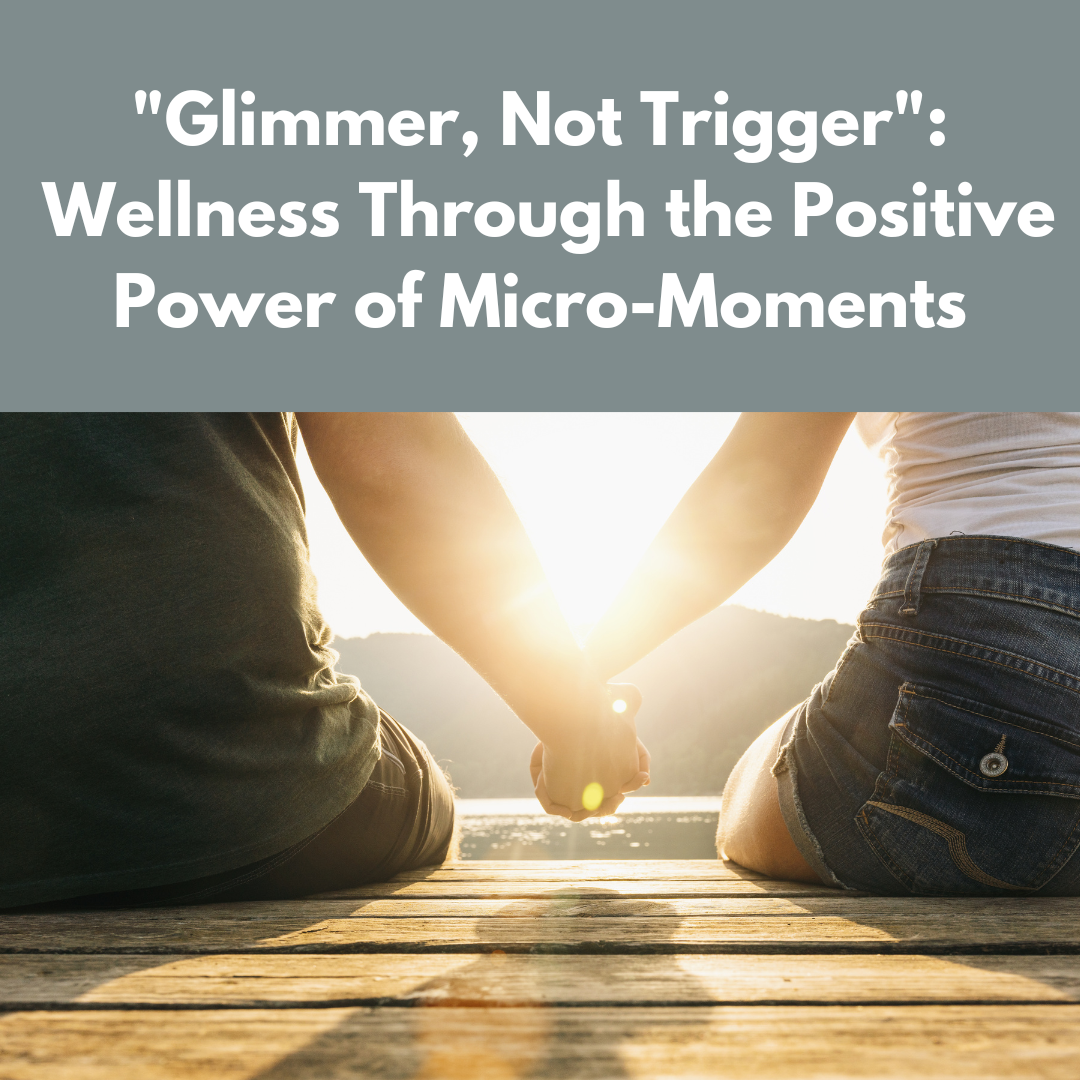
"Glimmer, Not Trigger": Wellness Through the Positive Power of Micro-Moments
Share
"Glimmer, Not Trigger": Wellness Through the Positive Power of Micro-Moments
In the stress-fuelled environment of modern life, mental and physical wellness trends often revolve around managing triggers—those internal and external stressors that cause us to feel anxious, overwhelmed, or reactive. However, there’s a new wellness trend gaining momentum that’s focused not on reducing or avoiding triggers, but on seeking out “glimmers”: small, joyful moments that ground us, bring calm, and evoke a sense of well-being. Welcome to the world of “Glimmer, Not Trigger,” where the focus is on finding and cultivating tiny, positive moments that collectively create a buffer against life’s challenges and help us build resilience.
Understanding the Science of Glimmers
At its core, the Glimmer, Not Trigger trend is grounded in neuroscience. The brain has a natural negativity bias, meaning it tends to focus more on negative experiences than positive ones. This bias has served humanity well in survival situations, allowing us to stay alert to danger. However, in our everyday lives, an over-attention to potential “threats” can lead to chronic stress, anxiety, and burnout.
Glimmers, as defined in this wellness trend, are brief moments that offer feelings of hope, safety, or joy. They’re not necessarily life-changing events but rather subtle experiences—a warm smile, the sound of laughter, the feel of sun on your skin—that register as positive, if only briefly. While triggers may activate a stress response in our bodies, glimmers activate a relaxation response, inviting us to pause, breathe, and fully experience a fleeting moment of peace or joy.
The Psychological Benefits of Glimmers
Focusing on glimmers has a profound impact on mental health. First, it allows us to practice mindfulness, the act of paying attention to the present moment without judgment. By actively seeking glimmers in our daily lives, we create more opportunities for gratitude and appreciation, which research shows can reduce stress and increase happiness.
Glimmers can also help us shift our baseline emotional state. Neuroscientist Dr. Lisa Feldman Barrett explains that emotions are not hardwired reactions but rather interpretations of sensations and contexts, influenced by our past experiences and mindset. Focusing on glimmers can “train” the brain to notice positive stimuli, thereby creating new emotional and cognitive pathways that counterbalance the brain’s negativity bias. Over time, this can lead to a more positive outlook, increased emotional resilience, and even a rewiring of the brain to seek out joy rather than stress.
Practical Ways to Cultivate Glimmers Daily
Incorporating glimmers into your daily life doesn’t require significant changes or special equipment. It’s about shifting your awareness and being open to experiences that evoke a sense of calm or pleasure. Here are some ways to start cultivating glimmers:
1. Morning Moments of Gratitude
Begin each day by recognizing three things you’re grateful for. They don’t have to be monumental—a good night’s sleep, a cozy blanket, or a cup of hot tea can be enough. This sets a positive tone for the day and primes your brain to seek out similar experiences.
2. Nature Breaks
Spending time in nature, even briefly, can provide glimmers of calm. A short walk in the park, listening to birds, feeling the grass beneath your feet, or even gazing at a tree outside your window can evoke a sense of peace and help regulate your nervous system.
3. Mindful Listening
Next time you hear music, laughter, or any sound that brings you joy, pause and really listen. Pay attention to the nuances, let it bring you into the moment, and notice how it makes you feel. Listening mindfully can transform a simple sound into a moment of connection and pleasure.
4. Savouring Daily Rituals
Whether it’s brewing your morning coffee, reading, or preparing a meal, slow down and savour the activity. Engage your senses—notice the aroma, texture, or taste, and let the experience absorb you. This mindfulness practice can help turn everyday tasks into micro-glimmers.
5. Expressing Kindness
Acts of kindness can create glimmers for both the giver and receiver. Compliment a co-worker, hold the door open, or offer a friendly smile to a stranger. These small acts of kindness foster connection and positive emotions, both essential to wellness.
6. Mindful Breathing
Take a moment to breathe deeply whenever you feel stressed or overwhelmed. With each inhale, acknowledge any tension; with each exhale, release it. This simple act can become a glimmer of calm that resets your mind and body.
7. Reflecting on Glimmers Each Evening
End your day by reflecting on the glimmers you experienced. Jot them down in a journal if you can. This simple practice reinforces the positive effects of glimmers and creates a library of joyful moments to reflect on when times get tough.
The Long-Term Impact of Embracing Glimmers
When we practice “Glimmer, Not Trigger,” we’re making a long-term investment in our mental health. Just as repeated exposure to stress can accumulate and lead to burnout, the consistent experience of glimmers can have a cumulative positive effect, creating a reserve of mental and emotional resources that act as a buffer against future challenges.
Over time, this shift can help improve emotional regulation, leading to less reactivity to negative stimuli and a stronger ability to focus on what matters. People who embrace glimmers report a greater sense of satisfaction, an increased capacity for empathy, and a stronger connection to their environment and community. In essence, by training ourselves to recognize and appreciate small moments of joy, we become more resilient, mindful, and fulfilled individuals.
Glimmers in the Workplace
The Glimmer, Not Trigger approach is also transforming workplace wellness. Stress and burnout are rampant across industries, with many wellness programs focused on reducing stressors. However, some companies are now exploring ways to incorporate glimmers into the work environment. Examples include:
- Creating Calming Spaces: Quiet rooms or small nature-inspired spaces where employees can take a moment to decompress.
- Encouraging Breaks: Encouraging employees to take short, mindful breaks to experience small moments of relaxation.
- Promoting Positive Feedback: Emphasizing recognition and praise can turn everyday tasks into opportunities for connection and satisfaction.
- Team-Building Activities: Incorporating enjoyable activities like art workshops, outdoor team outings, or meditation sessions to foster moments of connection and joy.
By focusing on glimmers, companies can foster a culture that prioritizes well-being and creates a more supportive, resilient workplace.
Why Glimmers Matter Now More Than Ever
In today’s world, we’re constantly bombarded with information, responsibilities, and pressures that can make life feel overwhelming. Glimmers offer an antidote—a way to step back, ground ourselves, and reconnect with the positive aspects of life. Unlike wellness trends that may require significant time, effort, or financial investment, seeking out glimmers is an accessible, adaptable practice that anyone can incorporate into their daily life.
The “Glimmer, Not Trigger” approach is a gentle reminder that while we may not always be able to control our environment or circumstances, we can control how we respond. By choosing to focus on glimmers, we empower ourselves to build resilience, improve our well-being, and ultimately lead more balanced, joyful lives.
Bringing Glimmers Into Your Community
One of the beautiful aspects of the Glimmer, Not Trigger trend is that it can be shared and encouraged within communities. Simple initiatives, like neighbourhood walks, collective moments of mindfulness, or group gratitude practices, can transform communities into supportive networks that foster resilience and joy. By prioritizing glimmers together, communities become more connected and compassionate, making it easier to weather tough times and celebrate good ones.
As this trend grows, it’s clear that glimmers are more than just a wellness tool—they’re a pathway to a richer, more mindful life. So next time you encounter a small moment of joy, pause, savour it, and recognize it as a glimmer. It might just be the start of a new chapter in your wellness journey, one that focuses on gratitude, connection, and the simple pleasures that make life meaningful.
